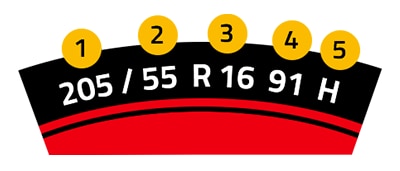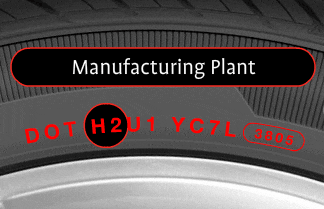-
- ELECTRIC VEHICLE
- PASSENGER
- LIGHT TRUCK & SUV/CUV
- COMMERCIAL TIRE
- ORIGINAL EQUIPMENT
- TIRE BASICS
- TIRE FINDER
TIRE MAINTENANCETIRE WEAR
Tire wear is caused by a combination of factors, including tire construction and quality, weather, road structure, and air pressure. Of all these factors, air pressure is most controllable by users.
ALIGNMENT
Proper alignment ensures that your vehicle handles correctly and will help increase the life and performance of your tires. Failure to keep your vehicle's wheels properly aligned can result in:
- Excessive tire wear
- Irreparable tire damage.
- Excessive fuel consumption and unsafe handling
Tires should be checked monthly for signs of irregular wear in both tread and shoulder areas. Irregular wear may indicate under-inflation or tire damage, or the need for wheel alignment or suspension repairs. A wheel alignment is also mandatory when a replacement set of tires is fitted to a car. Three key elements involved in wheel alignment that affect the vehicle's performance are:
CAMBER
The angle between a perpendicular line and a line drawn through the centerline of the tire when the vehicle is viewed from the front. Camber helps distribute the vehicle's weight across the tire contact patch during cornering for reduced tread wear and is used to fine tune a vehicle's handling characteristics. Incorrect camber causes uneven tire wear, poor steering and vehicle stability, and vehicle pull.
CASTER
The angle between a vertical line and a line drawn through the center of the ball joints (steering axis) when the vehicle is viewed from the side. An improper caster can cause hard steering, increased road shock, reduced straight line stability and cause the vehicle to pull one side or the other. A positive caster helps maintain directional control of the vehicle, helping to return the vehicle to a straight position when cornering, and helps compensate for the crown on a road. Most cars are engineered with a positive caster.
TOE
The angle between a line through the center of a vehicle and lines drawn through the centerlines of the tires when the vehicle is viewed from above. Toe alignment is the most critical to tire wear. Incorrect toe results in rapid and uneven wear.
VIBRATION & BALANCE
Incorrect balance is the largest cause of vehicle vibration. A wheel is out of balance when one area is heavier or lighter than the rest. This can cause uneven treadwear, increased vibration, and increased stress on the front-end parts that may cause them to wear prematurely. You should have your wheels balanced and aligned:
- Whenever a tire is replaced
- At the first sign of vibration or irregular treadwear
- When a balance weight is moved or removed
- Whenever you purchase new tires
INFLATION PRESSURE
You should check air pressure regularly because tires function properly only when they have the correct level of air pressure. If the air pressure is low or high, tire function deteriorates, resulting in tire damage, and possibly an accident. Manufacturers' recommended tire air pressure levels are indicated in your vehicle's user manual or on the inner part of the door. They vary slightly among various manufacturers.
TIPS
- When driving for an extended period of time, it is recommended that the air pressure be upwardly adjusted by about 4 psi
- Purchase a good pressure gauge and avoid often unreliable gas station gauges
TIRE SAFETY CHECK
Always look for bulges, cracks, cuts, penetrations and abnormal tire wear, particularly on the edges of the tire tread, which may be caused by misalignment or under inflation. Also check spare tires. Have an experienced tire technician immediately inspect the tire if any such damage is found. Continuing to use a damaged tire could result in tire failure causing serious injury or even death. Factors that can lead to accidents include:
SHALLOW GRIIVE DEPTH
When groove depth reaches 1.6MM, tires are prone to slip and can easily blow out from hitting sharp objects.
IMPROPER AIR PRESSURE
When used with low air pressure, tires generate high levels of heat. As a result, rubber and cord separate from each other, the cord is disconnected and the tire is blown out. Also, the edge of the tire is quickly worn away, shortening tire life. On the other hand, when the tire has too much air it becomes tense and is easily blown out or cut by external impact.
SCARRING
When tires run with nails, stones or other objects stuck in the tread groove, they can become flat or blow out. If the scar risks reaching the carcass, the tire must be immediately replaced.
ABNORMAL WEAR
Excessive or deficient air pressure and poor car wheel maintenance abnormally wear tires. Check tire air pressure, alignment, and rotation regularly, while refraining from improper driving habits such as sudden accelerating, braking and cornering.
WHEEL DAMAGE
Uneven load distribution on tires due to wheel damage may create friction between the rim fringe and the tire bead part, generating heat high enough to damage the cord and cause tire blow out.
TIRE ROTATION REMINDER
WHY ROTATE YOUR TIRES?
Regular tire rotation extends the life of your tires, saving you time and money. For rotation, each tire and wheel is removed from your vehicle and moved to a different position. This ensures that all of the tires wear evenly and last longer.
HOW OFTEN?
If no period is specified in your owner's manual, the tires should be rotated every 5,000 kilometers.




 korea
korea
 china
china
 japan
japan
 vietnam
vietnam
 australia
australia
 thailand
thailand
 germany
germany
 uk
uk
 spain
spain
 austria
austria
 russia
russia
 poland
poland
 france
france
 italy
italy
 NE/BAL(EN)
NE/BAL(EN)
 TÜRKIYE
TÜRKIYE
 usa
usa
 canada(EN)
canada(EN)
 brazil
brazil
 egypt
egypt

